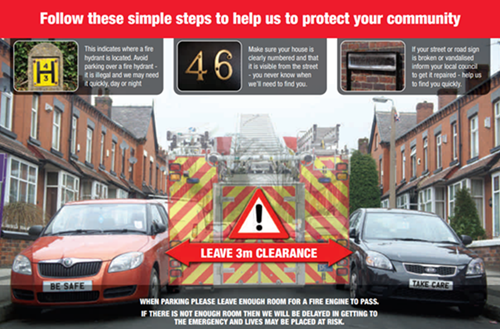
Sharing the Road
Staying Safe on our Motorways
Between 2020 and 2022 there has been 110 road casualties, killed or seriously injured on our motorway network in Greater Manchester. Casualty data taken from TFGM Data Base Collision Records, supplied by GMP and validated by Surveys Research & Analysis Department.
Read our useful tips on keeping you safe, whilst travelling on the motorway.
Drive Safe
-
Belt up - Seat Belts save lives
-
Avoid distractions, keep your eyes on the road at all times
-
Don't drink drive, remember you could still be over the limit the next day
-
Check your speed, the speed limit is not a target. In some road conditions, including fog and rain, even driving at the speed limit could be too fast
2 Second Rule
To use the rule, drivers should allow the vehicle in front to pass a fixed object, such as a lamp post or a road sign, then count to two seconds. If they reach two seconds before reaching the reference marker, they need to drop back. This advice is for dry conditions, if the weather is poor, you should leave a bigger gap.
Tips for Motorway Driving
-
Never drive in a lane closed by a red X
-
Keep to the speed limits shown on the gantries or signs
-
A hard shoulder is always identified by a solid white unbroken line, if there is no speed limit displayed about it or a red x is displayed, do not use it, except in an emergency
Smart Motorways
Around 10 per cent of the motorway network is now made up of smart motorways. So it's important to be able to recognise their features and how they work together.
A Red X Sign is used to identify when a lane is closed and indicates that drivers should move into an open lane to continue their journey. They are used on Smart motorways and other major routes to help manage traffic incidents, effectively and efficiently.
Have you noticed the Red X Signal when driving on Motorways? (National Highways website)
Travel Alerts (Traffic England website)
If you prefer to contact the Customer Service Teams at Highways England, they are available 24/7 and can be contacted by phone or email as below
Call 0300 123 5000 or Email info@nationalhighways.co.uk
What to do if an Emergency Vehicle approaches
The Highway Code Rule 219 says you should look and listen for ambulances, fire engines, police, doctors, or other emergency vehicles using flashing blue, red or green lights and sirens or flashing headlights, or if traffic officers and incident support vehicles using their flashing amber lights. Do not panic, consider the route of such a vehicle, and take appropriate action to let it pass, whilst complying with all traffic signals.
We recommend that you take the following actions if you should hear or see an emergency vehicle approaching.
- When you hear an emergency siren or see an emergency vehicle (blue lights) indicate and pull over steadily when and where it is safe to do so. Not on the brow of a hill or bend or road junction.
- Be aware that other emergency vehicles may also be going to the same incident. Once you have stopped and the first emergency vehicle has passed, have a good look round, check your mirrors and listen to ensure that no other emergency vehicles or other vehicles that may be around you, before signalling and driving on.
- Do not endanger yourself, other road users or pedestrians and avoid mounting the kerb.
- Do not brake harshly on approach to a junction or roundabout, as a following vehicle may not have the same view as you.
- Pedestrians must wait on the pavement away from the kerb or side of the road and keep looking and listening, ensuring no further emergency vehicles are coming, once all emergency vehicles have passed, keep looking & listening until it is safe to cross.
Advice on Rule 219 Emergency & Incident Support Vehicles (external website)
Advice on Pedestrian Safety (external website)
Parking & Street Safety Advice
There are simple steps that you can do to help us protect your community.
When parking please leave enough room for a Fire Engine to Pass. If there is not enough room, then we will be delayed in getting to the emergency and lives may be placed at risk.
- Fire Hydrants signs indicate where a fire hydrant is located.
- Leave 3 metres clearance in the road, to allow fire engines to pass.
- Don't park over fire hydrants this is illegal and we may need it quickly, day or night.
- Make sure your house is clearly numbered and that it is visible from the street, you never know when we'll need to find you.
- If your street or road sign is broken or vandalised, inform your local council to get it repaired, help us find you quickly.
